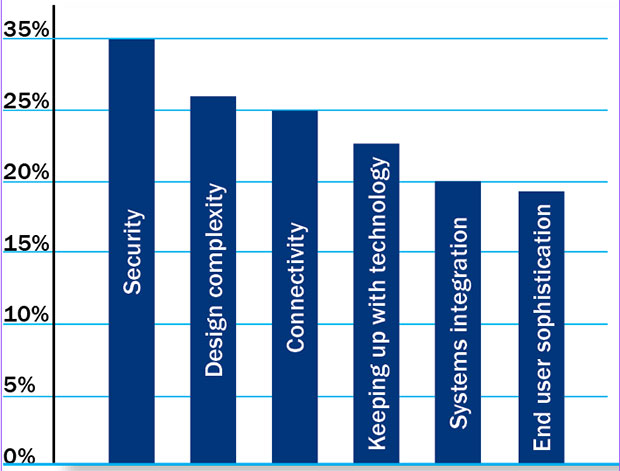
Security Concerns topped a list of challenges faced by Desktop Engineering survey respondents who were asked to note their top IoT design issues.
Latest News
March 1, 2015
 Security Concerns topped a list of challenges faced by Desktop Engineering survey respondents who were asked to note their top IoT design issues.
Security Concerns topped a list of challenges faced by Desktop Engineering survey respondents who were asked to note their top IoT design issues.Despite the current attention on the Internet of Things (IoT), the idea of sensor-enabled devices communicating with one another is not new. In 1926, famed electrical and mechanical engineer Nikola Tesla told Colliers magazine that “when wireless is perfectly applied,” Earth would be converted into a “huge brain” via “amazingly simple” instruments that would be small enough to fit in a vest pocket. It has taken some time to approach that perfect application of wireless technology, and the devices are not always simple, but in a survey of Desktop Engineering’s readers conducted earlier this year, most say the IoT is not hype. In fact, almost half of respondents are already involved or expect to be involved in IoT products and solutions.
Perfectly applying wireless technology is a high bar, and survey respondents admit they are struggling with connectivity. Of those respondents currently developing or expecting to develop IoT products, 52% said that they would like more training in communication technologies. That was the No. 1 training need cited. Connectivity was also in the top three IoT challenges respondents said they face, just behind “complexity of design and development.” If Tesla was prophetic when it came to wireless technology, he might have been talking about ease of use, not engineering, when he called those future wireless devices simple.
Security Tops Concerns
“I’m convinced that we are on the way to make almost everything connected,” said one engineering manager who responded to the survey. “The cost is now low and the technology is there. If we can figure out how to make it secure and reliable, I can’t see what will stop connecting almost everything to the Internet.”
Many respondents (35%) see security as the biggest hurdle to future IoT development, and 42% say they need more training related to securing the IoT. We address many aspects of IoT design in this issue, including security and the U.S. Federal Trade Commission’s involvement. The FTC released a report titled “Internet of Things; Privacy and Security in a Connected World” in January. It provides steps businesses can take to enhance and protect privacy and security, according to the FTC.
“The only way for the Internet of Things to reach its full potential for innovation is with the trust of American consumers,” said FTC Chairwoman Edith Ramirez in a statement announcing the report. “We believe that by adopting the best practices we’ve laid out, businesses will be better able to provide consumers the protections they want and allow the benefits of the Internet of Things to be fully realized.”
But consumers are just one aspect of IoT acceptance. The Industrial Internet of Things kicks off our IoT coverage this month. According to our survey, manufacturing and industrial applications were the top IoT areas being addressed by respondents.
“As with most technical innovations, there is more behind the scenes work required than it would seem from first glance at the news and publicity,” said one survey respondent. “Also there are so many options and the variety of protocols and equipment make it difficult to sort through and determine the optimal approach, as well as difficult to integrate disparate protocols or approaches.”
Because of those difficulties, we’ll continue to cover the IoT. Next month we explore IoT power requirements in the magazine and we’re presenting a webcast on secure IoT design April 7.
For more survey results, see the presentation below.
Subscribe to our FREE magazine, FREE email newsletters or both!
Latest News
About the Author
Jamie Gooch is the former editorial director of Digital Engineering.
Follow DE





